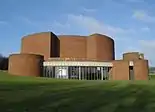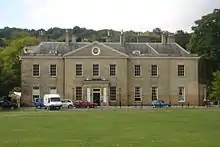Holy Trinity Church, Hove
Holy Trinity Church is a former Anglican church in Hove, in the English city of Brighton and Hove. Built in the early 1860s to provide extra capacity for Anglican worshippers in the rapidly growing town of Hove, its use declined in the 20th century and it was closed in 2007 following a Diocesan review. Until 2015—when a planning application to convert the building into a doctors surgery was approved—its future was uncertain, and a heritage group has described it as one of Britain's top ten threatened Victorian and Edwardian buildings. The church, which has been a medical centre since 2017, has Grade II listed status, reflecting its architectural and historic importance.
| Holy Trinity Church | |
|---|---|
 The south face and tower | |

| |
| 50.8312°N 0.1719°W | |
| Location | Blatchington Road, Hove, Brighton and Hove |
| Country | United Kingdom |
| Denomination | Anglican |
| Churchmanship | Evangelical |
| History | |
| Status | Church |
| Founded | 1861 |
| Founder(s) | Rev. John Fraser Taylor |
| Dedication | Holy Trinity |
| Consecrated | 15 June 1864 |
| Architecture | |
| Functional status | Redundant; threatened with demolition |
| Heritage designation | Grade II-listed |
| Designated | 2 November 1992 |
| Architect(s) | James Woodman |
| Groundbreaking | 1862 |
| Completed | 1864 |
| Construction cost | £9,000 (£891 thousand in 2021)[1] |
| Closed | 2007 |
History
Hove expanded rapidly in the second half of the 19th century, and the Cliftonville estate—developed from 1852—was one of its earliest areas of growth.[2] It was situated directly east of the old centre of Hove village on high-quality agricultural land which had been used to grow food for the nearby Brunswick estate.[3] The land was bought by four businessmen from Brighton[4] and was developed with nearly 300 houses, in various architectural styles, in the next nine years.[5]
St Andrew's, the old parish church of Hove, was close to the newly developed streets, but its capacity was often reached at services. Rev. John Fraser Taylor, a curate at St Andrew's, started planning a new church in 1861; a site was found and bought for £250 (equivalent to £23.5 thousand in 2021)[1] on Eaton Road (now Blatchington Road).[2] James Woodman, a local architect, was responsible for the design, and a builder named Cane constructed it. This took 14 months and cost a further £9,000 (£891 thousand in 2021).[1] The Bishop of Chichester, Ashurst Gilbert—who laid the foundation stone on 7 April 1863—consecrated the church on 15 June 1864. At that time, it consisted of chancel, nave, side chapels and a south aisle;[2] its tall tower on the south side was added in 1866. A spire was never added, although one had been planned.[6] In 1868, an aisle was built on the north side at a cost of £1,200 (£109 thousand in 2021).[1][7]
.JPG.webp)
In 1912, the church was given an open-air pulpit.[8][9] This rare feature, usually associated with churches with an evangelical tradition, was unique in Brighton and Hove.[8][6] Later additions included rooms under the wooden gallery in 1949, a vicarage in 1952 and a church hall in 1953.[8][6]
At first, Holy Trinity Church operated as a chapel of ease to St Andrew's Church.[2] After All Saints Church was built in 1892 and gained the status of parish church, Holy Trinity became part of its parish. This arrangement continued after the church was threatened with closure in the 1920s because of falling attendances, although it was allocated its own district.[8]
The Diocese of Chichester carried out a review of Anglican churches in the city of Brighton and Hove between 2002 and 2003. Its report, published in June 2003, recommended that Holy Trinity Church should close. It was said to have "no future" within the proposed Central Hove Collaborative Ministry, whose area would incorporate six places of worship in Hove. It was stated that the nearby Holy Cross church offered a similar type and tradition of worship, and no other church communities in the city were found to be suitable for church planting (i.e. moving one congregation and community wholesale into another building).[10] The Diocese of Chichester declared the church redundant on 1 September 2008, meaning it was no longer open for regular public worship.[11]
Architecture
The church is built mostly in red brick with stone dressings and some black and yellow brickwork.[9][12] Its architectural style is difficult to specify; cases have been made for "Lombardo-Gothic", Italian Gothic, standard Gothic, Early English and Eclectic.[9][7][6][12][13] The design has been criticised as "ignorant beyond belief", echoing architect and architecture lecturer Harry Stuart Goodhart-Rendel's comments about another Hove church, St John the Baptist's, in 1918.[7][6]
Holy Trinity Church has a nave of four bays, aisles on each side, chancel, apse, gallery at the west end with two rooms below, organ chamber on the northeast side (containing an organ originally installed in 1883 and later converted to electric operation), vestry at the southeast corner and entrance porch on the south side, above which the battlemented tower rises in three stages.[6] (The porch is incorporated into the base of the tower.)[9][12] The font was made in 1878 and consists of Caen stone and marble from Sicily.[6] The interior is plain.[12] Some of the windows contain stained glass; one commemorates Rev. John Fraser Taylor's parents, and he has his own memorial tablet in the chancel.[8]
The church today
In March 2009, the church was threatened with demolition and a housing development was proposed for the site.[14] Local residents, including actor Brian Capron, have campaigned against this.[15] The diocesan review in 2003 proposed using the building as second-stage accommodation for homeless people who had lived in the St Patrick's Church homeless shelter.[10] Brighton and Hove City Council has also considered using the land for a new primary school.[16] In 2008, The Victorian Society, an architectural study and preservation group and national charity, identified the church as one of Britain's ten most threatened Victorian and Edwardian structures.[14] In March 2011, Brighton and Hove NHS Trust announced that it was considering combining two local doctors' practices and moving them from their existing premises in central Hove into the former church. If local people approved and planning permission had been granted, the Trust would have created a "spacious, fully accessible medical centre on three floors within the shell" of the church. A completion date of the end of 2012 was suggested.[17] This scheme was abandoned, but in January 2015 a revised planning application was submitted. This proposal again involves the conversion of the church into a three-storey medical centre housing two general practices, but it also includes a single-storey extension to accommodate a pharmacy.[18] Brighton and Hove City Council approved the planning application in July 2015.[19] Specialist building development company Medical Centre Developments bought the building in February 2016 and planned to start converting it the following month.[20] Trinity Medical Centre, formed as a result of two general practices in central Hove merging, was inaugurated at the former church in 2017.[21] A three-floor, 1,300-square-metre (14,000 sq ft) suite of surgeries has been created in the church interior. There is also a newly built onsite pharmacy.[22]
The church was listed at Grade II by English Heritage on 2 November 1992.[6] It is one of 1,124 Grade II-listed buildings and structures, and 1,218 listed buildings of all grades, in the city of Brighton and Hove.[23]
See also
Notes
- UK Retail Price Index inflation figures are based on data from Clark, Gregory (2017). "The Annual RPI and Average Earnings for Britain, 1209 to Present (New Series)". MeasuringWorth. Retrieved 2 February 2020.
- Dale 1989, p. 119.
- Scott 1995, p. xii.
- Middleton 1979, p. 52.
- Middleton 1979, p. 53.
- Historic England. "Holy Trinity Church, Blatchington Road, BN3 3TA, Brighton (Grade II) (1187541)". National Heritage List for England. Retrieved 20 February 2013.
- Dale 1989, p. 120.
- Dale 1989, p. 121.
- Elleray 2004, p. 34.
- "Strengthening the Church for God's Mission" (PDF). Report from the Brighton and Hove Deaneries Pastoral Strategy Review Group. Diocese of Chichester. 21 June 2003. Archived from the original (PDF) on 9 October 2003. Retrieved 20 March 2009.
- "The Church of England Statistics & Information: Lists (by diocese) of closed church buildings. Diocese of Chichester" (PDF). Church of England. 21 February 2011. Archived from the original (PDF) on 16 May 2012. Retrieved 5 November 2020.
- Nairn & Pevsner 1965, p. 436.
- Salzman, L.F. (ed.) (1940). "A History of the County of Sussex: Volume 7 – The Rape of Lewes. The Borough of Hove". Victoria County History of Sussex. British History Online. pp. 262–265. Retrieved 22 March 2009.CS1 maint: extra text: authors list (link)
- "Has God's gem lost its sparkle?". BBC Southern Counties Radio website. BBC. 25 September 2008. Archived from the original on 21 February 2013. Retrieved 21 February 2013.
- "Actor in "Save our Church" campaign". The Argus. Newsquest Media Group. 7 September 2008. Archived from the original on 16 January 2015. Retrieved 16 January 2015.
- "Threatened Hove church could become school". The Argus. Newsquest Media Group. 15 September 2008. Archived from the original on 21 February 2013. Retrieved 21 February 2013.
- Roberts, Anna (19 March 2011). "Health bosses consider moving GPs into Hove church". The Argus. Newsquest Media Group. Archived from the original on 16 January 2015. Retrieved 16 January 2015.
- Yeomans, Emma (16 January 2015). "Plans to convert derelict church into surgery back on". The Argus. Newsquest Media Group. Archived from the original on 16 January 2015. Retrieved 16 January 2015.
- Ryan, Siobhan (12 July 2015). "GPs to open on old church site". The Argus. Newsquest Media Group. Archived from the original on 12 July 2015. Retrieved 12 July 2015.
- Ryan, Siobhan (13 February 2016). "Work to convert former church into new GP surgery starts next month". The Argus. Newsquest Media Group. Archived from the original on 13 February 2016. Retrieved 13 February 2016.
- "Welcome to Trinity Medical Centre, Hove". Trinity Medical Centre. 2020. Archived from the original on 24 September 2020. Retrieved 5 November 2020.
- "About Us". Trinity Medical Centre. 2020. Archived from the original on 15 August 2020. Retrieved 5 November 2020.
- "Images of England — Statistics by County (East Sussex)". Images of England. English Heritage. 2007. Archived from the original on 27 December 2012. Retrieved 27 December 2012.
Bibliography
- Dale, Antony (1989). Brighton Churches. London EC4: Routledge. ISBN 0-415-00863-8.CS1 maint: location (link) CS1 maint: ref=harv (link)
- Elleray, D. Robert (2004). Sussex Places of Worship. Worthing: Optimus Books. ISBN 0-9533132-7-1.CS1 maint: ref=harv (link)
- Middleton, Judy (1979). A History of Hove. Chichester: Phillimore & Co. ISBN 0-85033-325-3.CS1 maint: ref=harv (link)
- Middleton, Judy (2002). The Encyclopaedia of Hove & Portslade. Brighton: Brighton & Hove Libraries.CS1 maint: ref=harv (link)
- Nairn, Ian; Pevsner, Nikolaus (1965). The Buildings of England: Sussex. Harmondsworth: Penguin Books. ISBN 0-14-071028-0.CS1 maint: ref=harv (link)
- Scott, Eddie (1995). Hove: A Pictorial History. Chichester: Phillimore & Co. ISBN 0-85033-981-2.CS1 maint: ref=harv (link)


.jpg.webp)


.jpg.webp)
